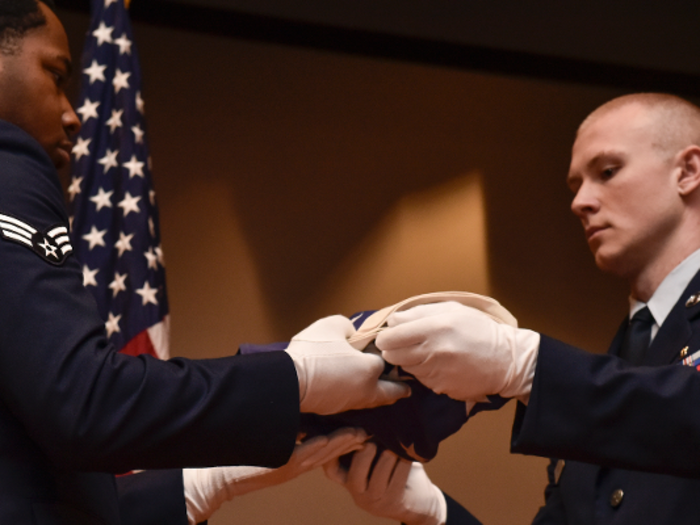- Home
- slideshows
- miscellaneous
- Military pay: This is how much US troops are paid according to their rank
Military pay: This is how much US troops are paid according to their rank
E-1: $20,172

E-2: $22,608

Service members automatically promote to the E-2 paygrade — Airman (Air Force), Private (Army), Private 1st Class (Marine Corps), Seaman Apprentice (Navy) — after 6 months of service.
Their pay increases to $1,884 per month.
E-3: $23,772

Promotion to the E-3 occurs automatically after 12 months of service. Airman 1st Class (Air Force), Private 1st Class (Army), Lance Corporal (Marine Corps), Seaman (Navy).
Basic pay is $1,981 at this rank, adding up to a $427 monthly increase in pay after one year on the job.
E-4: $27,684

Although time in service requirements vary between each branch, service members who promote to E-4 typically have at least two years of service. Senior Airman (Air Force), Specialist/Corporal (Army), Corporal (Marine Corps), Petty Officer 3rd Class (Navy)
If an E-3 doesn't advance in paygrade after two years, their pay will still increase to $2,195 rounded to the nearest dollar.
For those who do make E-4 with two years, pay will increase to $2,307 per month. Some service members will promote to the next rank after just one year at this paygrade — those who remain at the E-4 level will see a pay raise to $2,432 per month after spending three years in service.
E-5: $32,136

Promotions are no longer automatic, but troops can advance to E-5 with as little as three years in service. Those ranks are Staff Sergeant (Air Force), Sergeant (Army/Marine Corps), Petty Officer 2nd Class (Navy).
For these troops, their new paychecks will come out to $2,678 per month.
Service members will commonly spend at least three years at this paygrade. While they do not advance in rank during that time, their pay will still increase along with their time in service.
Four years after enlistment, an E-5 will make $2,804 per month. After six years of service, their pay will increase again — even if they do not promote — to $3,001 per month.
E-6: $39,048

It is unusual for a service member to achieve the rank of E-6 — Technical Sgt. (Air Force), Staff Sgt. (Army/Marine Corps), Petty Officer 1st Class (Navy) — with fewer than six years of service.
An "E-6 with six" takes home $3,254 per month.
After another two years in the service, that will increase to $3,543 in monthly salary, equating to approximately $42,500 per year.
Achieving the next higher paygrade, E-7, before serving for 10 years is not unheard of but not guaranteed. If an E-6 doesn't advance by then, they will still receive a pay raise, taking home $3,656 a month.
Their next pay raise occurs 12 years after their enlistment date, at which point their monthly pay will amount to $3,875.
E-7: $47,340

Achieving the coveted rank of E-7 — Master Sergeant (Air Force), Sgt. 1st Class (Army), Gunnery Sgt. (Marine Corps), Chief Petty Officer (Navy) — with fewer than 10 years of service is not common, but it can be done.
Those who achieve this milestone will be paid $3,945 a month, increased to $4,072 per month after reaching their 10-year enlistment anniversary.
Some service members retire at this paygrade — if they do, their pay will increase every two years until they become eligible to retire. When they reach 20 years, their pay will amount to $4,798 per month — or $57,576 yearly.
The military places a cap on how long each service member can spend in each rank. Commonly referred to as "up or out," this means that if a service member doesn't advance to the next rank, they will not be able to reenlist. While these vary between branches, in the Navy that cap occurs at 24 years for chief petty officers.
A chief with 24 years of service makes $5,069 per month.
E-8: $55,884

Service members may promote to E-8 — Senior Master Sgt. or 1st Sgt. (Air Force), 1st Sgt. or Master Sgt. (Army), Master Sgt. or 1st Sgt. (Marine Corps), Senior Chief Petty Officer (Navy) —with as little as 12 years of service.
At that point, they will receive $4,657 per month.
Troops who retire as an E-8 after 20 years of service will take home a monthly salary of $5,374 — or $64,488 per year.
If they stay in past that point, they will receive raises every two years.
An E-8 with 28 years in the service makes $6,076 monthly.
The Army's up-or-out policy prevents more than 29 years of service for each 1st Sgt. or Sgt. Maj.
E-9: $66,960

E-9s have anywhere from 15 to 30 years of experience, although few selected for specific positions may exceed 30 years of service. Their titles are Chief Master Sgt. (Air Force), Sgt. Maj. (Army), Master Gunnery Sgt. or Sgt. Maj. (Marine Corps), Master Chief Petty Officer (Navy).
Service members who achieve this rank with 15 years of experience will be paid $5,580 per month.
They'll receive their next pay raise when they reach 16 years, and take home $5,758 monthly.
After 20 years, they will take home $6,227 — that's $74,724 yearly when they reach retirement eligibility.
Some branches allow E-9s to stay in the military up to 32 years, at which point they will make $7,475 — or $89,700 per year.
O-1: $38,256

Compared to enlisted service members with the same amount of experience, military officers make considerably more money.
A freshly commissioned O-1 — 2nd Lt. (Army/Marine Corps/Air Force), Ensign (Navy) — earns $3,188 per month in base pay alone.
O-2: $50,208

Officers are automatically promoted to O-2 after two years of service. This is a highly anticipated promotion, as it marks one of the largest individual pay raises officers will see during their careers. Those ranks are 1st Lt. (Air Force/Army/Marine Corps), Lt. j.g. (Navy).
An O-2 earns $4,184 per month, which comes out to $50,208 a year.
O-3: $68,052

Officers will receive a pay raise after reaching three years in service.
Using the Army's average promotion schedule, officers will achieve the next rank automatically after four years in the service.
New captains and lieutenants, with four years of service, make $5,671 per month. At this rank, officers will receive pay raises every two years.
O-4: $86,832

By the time they reach the rank of O-4, military officers will have spent an average of 10 years in the service. Maj. (Air Force/Army/Marine Corps), Lt. Cmdr. (Navy)
A major or lieutenant commander with a decade of experience takes home $7,236 per month, or just under $86,832 a year. Officer pay continues to increase with every two years of additional service.
O-4 pay is capped at $8,074 a month, so if an officer wants to take home a six-figure salary — additional pay, bonuses and allowances aside — they'll have to promote to O-5.
O-5: $105,012

Officers typically spend at least 17 years in the military before promoting to O-5.
They'll take home $8,751 per month until their 18-year commissioning anniversary, at which point they'll earn $8,998 per month. Those ranks are Lt. Col. (Air Force/Army/Marine Corps), Cmdr. (Navy).
After 18 years in the military, officers receive annual compensation of nearly $108,000 a year.
O-6: $130,092

"Full bird" colonels and Navy captains, with an average 22 years of service, are compensated $10,841 per month.
Officers who do not promote to become a general or admiral must retire after 30 years of service. At this point, they will be making $11,668 a month, or roughly $140,000 per year.
O-7: $155,820

Promotion to brigadier general and rear admiral depends on a wide range of variables, including job availability.
Each of these ranks carries its own mandatory requirement; similar to the enlisted "up or out" policies, officers must promote to the next higher rank or retire.
Officers who have spent less than five years at the lowest flag rank must retire after 30 years of service. Their last pay raise increased their monthly salary to $12,985.
O-8: $184,572

Generals and admirals with two stars — Maj. Gen. (Air Force/Army/Marine Corps), Rear Adm. (Navy) — must retire after their 35th year in the military.
At this point, they will be earning $15,381 per month, or $184,572 a year.
O-9: $189,600

Military officer pay is regulated and limited by US Code.
Both three- and four-star admirals and generals who stay in the service long enough will receive the maximum compensation allowed by the code. These ranks are vice admiral for the Navy and lieutenant general for the other branches.
Excluding additional pays, cost of living adjustments, and allowances, these officers make up to $15,800 every month.
That's about $189,600 a year.
O-10: $189,600

Regardless of continued time in service, once a military officer achieves the four-star rank of general or admiral, they will no longer receive pay raises and are capped at $15,800 per month.
Extra pays and allowances help take their salaries a bit further.

Base pay can seem stingy, especially at the lower ranks where enlisted receive around $20,000 per year.
But troops receive a number of benefits and may qualify for extra allowances.
TRICARE Prime, the military's primary healthcare package, is free for active duty troops — saving them the $6,896 average annual premium for single payers.
When eligible to live off base, service members receive a basic allowance for housing (BAH), which increases at each paygrade; the exact amount is set based on location and whether the individual has any children. Service members also receive allowances to help cover the cost of food and in expensive duty locations receive a cost of living allowance (COLA). Enlisted personnel also receive a stipend to help them pay for their uniforms.
Any portion of a service member's salary that is labeled as an "allowance" is not taxed by the government, so service members may only have to pay taxes for roughly two-thirds of their salary.
Popular Right Now
Popular Keywords
Advertisement